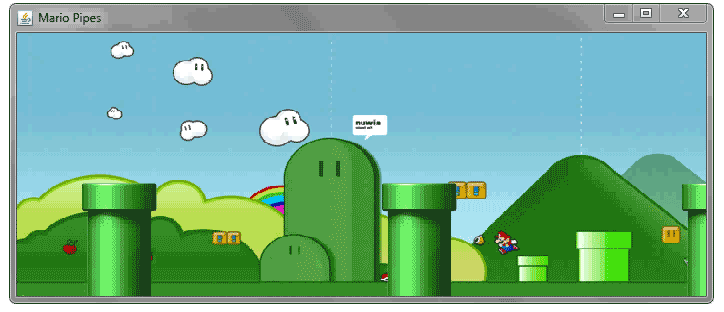在此之后提出了新问题,在此处找到。
我是 Java 新手,但我正在开发“Flappy Bird”,以了解有关 Java 和图形显示方式的更多信息。非常感谢对我的任何问题的任何解决方案或建议。谢谢!
现在,我的程序创建了一个随机管道并滚动它,但我不需要它来保持滚动x1-3 = -83(这是管道将完全离开屏幕并且不再需要的时候)。
问题
如何使我的Game.class滚动不止一个实例,Pipes.class同时在它们之间添加预设距离?我可以找出它们之间的距离,但就显示多个而言,我不知道该怎么做。最多只能同时显示 3 个管道。
如何为主菜单显示一个面板,然后在按下开始按钮后切换到管道面板?
课程
游戏.java
import java.awt.event.ActionEvent;
import java.awt.event.ActionListener;
import javax.swing.JFrame;
import javax.swing.JPanel;
import javax.swing.SwingUtilities;
import javax.swing.Timer;
public class Game {
Pipes panel = new Pipes();
public Game() {
JFrame f = new JFrame();
f.setDefaultCloseOperation(JFrame.EXIT_ON_CLOSE);
f.add(panel);
f.setTitle("Pipe Game");
f.setResizable(false);
f.pack();
f.setLocationRelativeTo(null);
f.setVisible(true);
Timer timer = new Timer(10, new ActionListener() { //pipe speed
@Override
public void actionPerformed(ActionEvent e) {
panel.move();
}
});
timer.start();
Timer refresh = new Timer(30, new ActionListener() { //refresh rate
@Override
public void actionPerformed(ActionEvent e) {
panel.repaint();
}
});
refresh.start();
}
public static void main(String args[]) {
SwingUtilities.invokeLater(new Runnable() {
@Override
public void run() {
new Game();
}
});
}
}
管道.java
import java.awt.Dimension;
import java.awt.Graphics;
import javax.swing.JPanel;
public class Pipes extends JPanel {
//Declare and initialiaze variables
int x1 = 754; //xVal start
int x2 = 75; //pipe width
//total width is 83
int y1 = -1; //yVal start
int y2 = setHeightVal(); //pipe height
int gap = 130; //gap height
@Override
public void paintComponent(Graphics g) {
super.paintComponent(g);
g.clearRect(0,0,750,500); //Clear screen
g.drawRect(x1,y1,x2,y2); //Draw part 1
g.drawRect(x1-3,y2-1,x2+6,25); //Draw part 2
g.drawRect(x1-3,y2+25+gap,x2+6,25); //Draw part 3
g.drawRect(x1,y2+25+gap+25,x2,500-y2-49-gap); //Draw part 4
}
public void move() {
x1--;
}
public int getMyX() { //To determine where the pipe is horizontally
return x1-3;
}
public int getMyY() { //To determine where the pipe is vertically
return y2+25;
}
public int setHeightVal() { //Get a random number and select a preset height
int num = (int)(9*Math.random() + 1);
int val = 0;
if (num == 9)
{
val = 295;
}
else if (num == 8)
{
val = 246;
}
else if (num == 7)
{
val = 216;
}
else if (num == 6)
{
val = 185;
}
else if (num == 5)
{
val = 156;
}
else if (num == 4)
{
val = 125;
}
else if (num == 3)
{
val = 96;
}
else if (num == 2)
{
val = 66;
}
else
{
val = 25;
}
return val;
}
@Override
public Dimension getPreferredSize() {
return new Dimension(751, 501);
}
}
